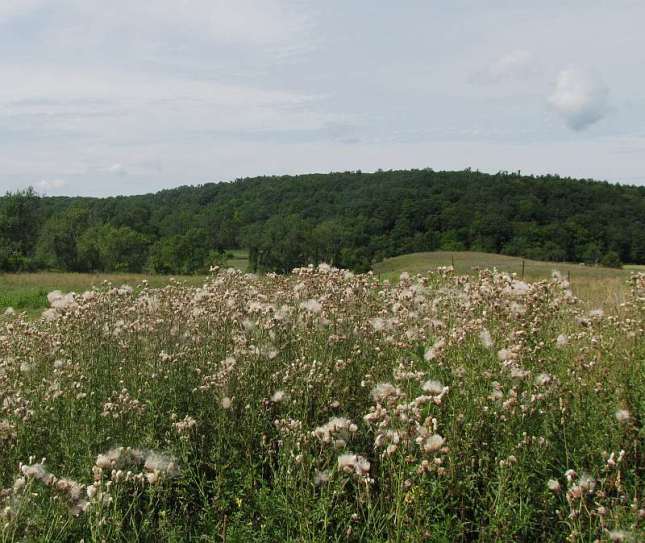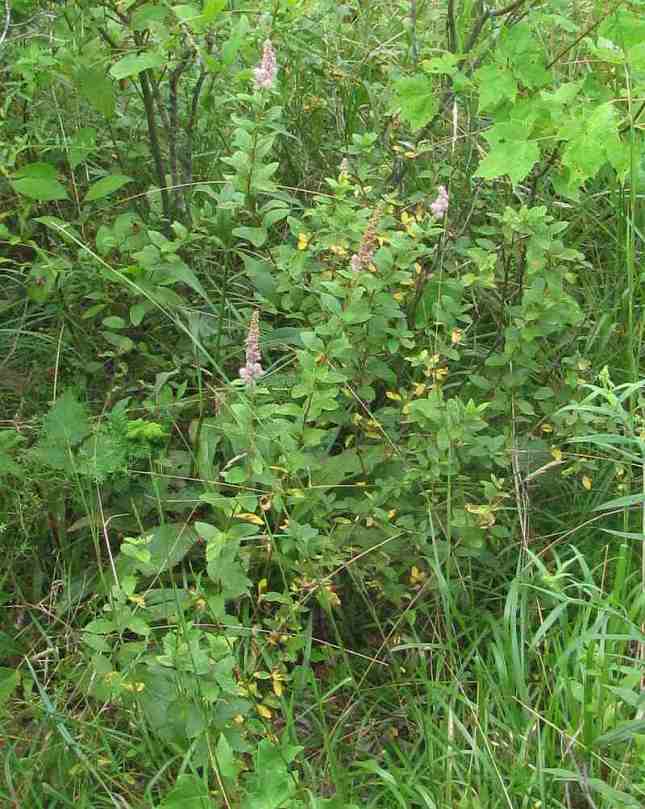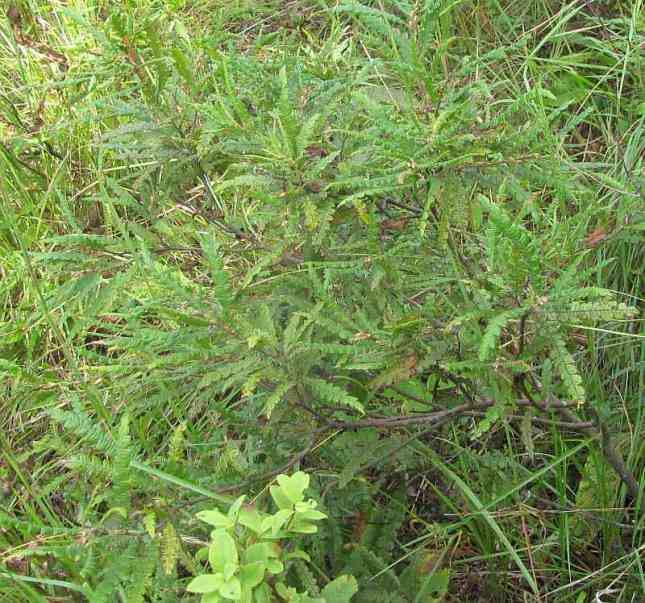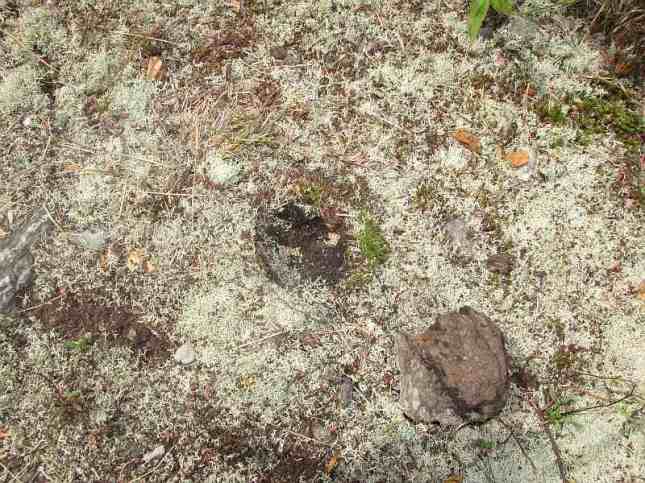See what the site of our visit looked like from the air in 1942 or 2009. (The yellow circle indicates the location of the rocky, dry slope where we ended our outing). Note especially the extent of forest.

What was once forest is now field with forest creeping in from the edges and from toe-holds within the fields. The field in the foreground is dominated by European grasses and weeds, although here and there native plants such as Little Bluestem and Milkweed appear.

The thistle on the lowlands, an exotic weed, has passed from flower to fluff; the wind was carrying the tufts off like feathered balloons.

This Buckeye butterfly flitted across the field as we arrived. Buckeyes don't overwinter in our area; rather, they are migratory. In some years, such as this one, there seem to be more of them about. In other years, we don't see a one.

Also present are old field butterflies like this Northern Broken Dash, here perched atop Spotted Knapweed. Its caterpillars feed upon our relatively common "panic grasses". Neither those grasses nor this butterfly are very common in these fields.

We have seen few Monarchs this year, but there were several dodging back and forth across this field when we visited. Apparently, they were able to find the scattered clumps of Milkweed...

This Monarch caterpillar is well on its way. Monarchs aren't the only insects using the Milkweed. There were Black and Red Milkweed Beetles. And some plants are spattered with aphids.

These yellow aphids are being tended by the "Somewhat Silky Ant", a common visitor to field, home and picnic. Its silvery sheen is caused by a fine coating of hairs over most parts of its body.

The silver sheen of the "Somewhat Silky Ant" is better seen in this photograph of two ants comparing notes on a Milkweed leaf.

The big eyes and dark coloration of the "Somewhat SIlky Ant" are perhaps typical of ants that spend much of the day out and about. However, across our various ant species, there is much variation in body size, texture, color and shape.

Forest edges into the field both spontaneously (when pieces are abandoned and reforest through the natural return of woody plants) and through plantings. These Scotch Pine were planted decades ago on an abrupt ridge that was probably difficult to farm.

Within that same pine stand, one finds a cooler, somewhat moister microclimate (that's our dog poised in the clearing). We pick up a few forest-dwelling ants in this little pocket.

This is a "Broken-Back Ant" nest. These are generally woodland-dwelling species. Like most ants they'll eat a variety of foods (that is, they're 'omnivores'), but this group is also known to disperse plant seeds because of its predilection for the food packets that some sedges and spring flowers attach to their tiny seeds in much the same way that other plants create larger fruits, such as cherries or blackberries, which then attract birds who carry those seeds elsewhere.

This is a "Broken Back Ant", so-called because its thorax (the part behind the head) is long and contorted. It is also armed with sharp spines, as are the backs of several other groups of ants. Some say that such spines help protect the spindle-thin waist from attackers. Who knows. Ant society does not seem to be a peaceful place, and attacks from other ants seem common, so a tendency to evolve protection against such attacks seems possible. How much poking power these relatively short spines would provide is unclear.

This Sugar Maple was probably left in the middle of the field for shade. Given its distance from the farmhouse, it's hard to believe that tapping for maple syrup provided any motivation, although settlers did favor Sugar Maples, and our forest seems to have more Sugar Maples in it now than prior to European settlement. The low-hanging branches and adjacent fencerow can discourage grazers and hay makers, and form an initial 'crystallization point' for returning forests.

The butterflies and moths we find in these fields seem to have come in mainly for the nectar sources. The caterpillars of Spicebush Swallowtail, here seen drinking at a still-flowering Thistle, probably feed on its namesake in the adjacent wet forest.

Although the Spicebush strongly resembles the Black Swallowtail, it is slightly larger and, as this wings-open perspective shows, has a larger blue patch on its hindwings and less yellow.

Likewise this unfortunate Small-Eyed Sphinx, being eaten by the Jumping Spider attached to its abdomen, has caterpillars who feed on woodland plants such as Cherries and Shadbush.

This rocky prominence is slowly reverting to forest. The thin soils may have been made even thinner by the work of grazers' hooves which sloughed the delicate mantle of dirt off of the smooth bedrock. Left to its own devices, this area supports many of our native plants. These are more adept at living on such lands than the European plants brought over to grow in rich gardens or farm fields. The tall, bright green grass to the left of the rocks is Little Bluestem.

Little Bluestem grows in discrete bunches and is a 'warm season grass' meaning that its most exuberant growth occurs relatively late in the summer when many of our other grasses are beginning to look more 'tired'. In autumn, it will add a beautiful almond haze to this hillside.

This Spirea, Steeplebush, also grows in the rocky 'savanna' (savanna refers to an area where woody plants are interspersed with large areas of more open lands). Meadowsweet, a white Spirea, grows nearby here; both are native to our area.

"Sweetfern" is, in fact, no fern at all. But it does have fern-like leaves and when those leaves are crushed, they are sweetly aromatic.

Reindeer Lichen (so named because reindeer reportedly eat a tundra relative) grows thick and brittle on the rocks.

Nestled in one clump of lichen was this ant nest (the rock that covered it has been put to one side).

The nest in the previous photograph and the one in the photograph here are of small "Lasius" ants. These ants apparently live most of their lives below ground, tending and 'milking' various root-dwelling insects.

As perhaps befits their underground life style, Lasius tend to be paler ants with relatively small eyes. At least one of Lasius species is holarctic meaning that it naturally occurs in both North America and Eurasia.

These red and black "Formica" ants are common midst the rocks and dry vegetation (indeed, in our neck of the woods, ants generally seem more common in dry areas; somewhat the reverse of ground beetles). There are various kinds of such ants, but almost all are raiders of other ant's nests or frequent victims of such raids. Apparently, the majority of such raids are in search of forced recruits to the ranks of the raiding nest's workers, rather than attacks for food (although that happens too) or attempts to oust other ants from preferred nesting sites. Many of these are 'mound building' ants such as those also mentioned in our 13 May 2011 blog entry. Compare the profile of this ant to that of the "Broken Back Ant" pictured earlier - there's a lot of room for variation in the architecture of what we just generally describe as 'ant'!

This is the mound of one such ant, albeit from May and from Hawthorne Valley itself. It is however located in the same kind of dry, rocky habitat. The choice of such habitat may be due in part to the fact that it tends to stay open (due to the rocks) and yet is rarely subjected to the intense mowing or grazing that would quickly destroy the mounds. That said, many mound builders can and do make less conspicuous nests.

Aside from the ants in this 'savanna', some of whom are generally described as forest-dwellers, other insects also hint at a woody future. This Brown Stink Bug, pictured here on the somewhat unnatural background of my backpack, apparently feeds most commonly on oaks.

Perhaps including trees such as this Black Oak found nearby. Black Oak seems to occur in dry forests in our area - not as dry perhaps as where we find Chestnut Oak, but not as rich as prime habitat for White Oak or Red Oak (although both of these species were also in the neighborhood).

The future for this dry knoll? This shot, which looks like a green mish-mash, is full of some of the trees that may come to dominate. The Birch, whose gnarled trunk suggests senescence, may have come in when this was first abandoned open land. As the forest thickens, the Birch will probably give way to trees such as Shagbark Hickory, Red Maple, and those White or Red Oaks; all species who seem to have saplings in the foreground of this picture. Or perhaps, if some level of grazing is maintained by livestock or deer, or if a rare grass fire burns through, then the savanna and its ants and plants will persist for a bit longer.

While much of this blog was put together with ingredients from the sun-drenched fields, some of it happened here. At my nighttime desk, beneath the microscope, the only place where I can really get a good look at those ants, put names to them, and hence, add another ecological color - or level of understanding - to this landscape.





Graham Hawks
August 3, 2011 at 12:42 am
Just a delightful….wonderful blog.
‘Savannah’ is such a beautiful and useful descriptive word in ecology. It is so helpful to communicate the nature of such a habitat especially in the east where one normally might not identify such a habitat but where it does occur whether from microclimatic, edaphic or disturbance conditions. Wes Jackson, the founder of the Land Institute in Salina, Kansas was always fond of saying “humans evolved to be upright beings so they could see over the great grasses of the African Savannas”. He would often regale us with such romantic tales of connection along with the mysterious attraction men had for the great tall-grass prairies in Kansas as a sign of genetic memory from our time of evolution in the savanna’s of Africa. I always used to think of such stories when working in the Post Oak/Black Jack Oak savannas as one approached the 100th meridian in Kansas and Oklahoma: true and incredibly beautiful macroclimatic savannas with these trees broadly dispersed among the encroaching native western prairie grasses.
Thanks for inspiring my dreams with the seemingly ‘ordinary’ (but truly beautiful) microhabitats along the roadside in our own homeplace.
Graham